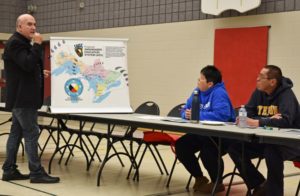Voters have chance to cast ballot at information session

By Kelly Anne Smith
NIPISSING FIRST NATION—It’s getting to be crunch time for the vote for the new Anishinabek Education System (AES).
With the end of November vote approaching, administrators and educators are working diligently to get the word out and help people to make an informed choice.
At Nipissing First Nation’s (NFN) final information session at Nbisiing Secondary School, members were out to hear Fred Bellefeuille, Union of Ontario Indian’s legal counsel. He explained how the new AES system will be laid out in the territory.
He introduced Ester Gilbank, Regional Communications Coordinator. Gilbank explained the Anishinabek are people of the good heart. “We are the original people.”
Mike Restoule received tobacco from Gilbank to read the preamble to the constitution. Restoule introduced himself in Anishinaabe.
“I am from Nipissing First Nation and the Anishinek Nation. Ani,Bonjour,” stated Restoule. He then told the group his name. “The reason I say my name in the Objibway language is because the Elders tell us that whenever Anishnaabe people get together, a lot of the ancestors, who are maybe in the room with us, listening to us, can’t understand the English language. They are old, old ancestors. If you want them to hear you or to know who you are in the room, you should introduce yourself in the language.”
Bellefeuille started his talk by saying, “We are all relatives that live throughout our nation. The Nipissing’s travelled all the way to Lake Nipigon to escape the Iroquois. We stayed for about 25 years, a generation.”
Bellefeuille pointed to a map of Union of Ontario Indians territory outlined by bear claws. “This is all our territory with all our relatives from the Robinson Huron Treaty. Robinson Superior is up here. We decided to combine our strength to establish the Anishnabek Education System. And all of these first nations are coming together to vote.”
The five bear claws represent regions which could physically change after the vote depending on which First Nations vote for the AES. There will be the equivalent of a school board—the Kinoomaadziwin Education Body—with a coordinator and an assistant appointed to it from a regional council made up of representatives from each participating First Nation’s education authority.
Fran Couchie is recently retired as the Director of the Board of Education at Nipissing First Nation. Couchie knows children on and off-reserve will have a better chance at accessing resources.
“If we vote yes to this, then there is a partnership with the provincial government’s Ministry of Education,” stated Couchie. She explained a common scenario. “You call because your child is struggling and should have a needs assessment. But you’re told sorry; the funding we have can only be used for on-reserve members.”
Couchie is future positive. “Nbisiing School is a good example right here. And it is doing very well. But there is even more we could be doing with human resources and financial resources in a system supporting us. Yes, Chief and Council have been big supporters, but for the most part, they are not educators. They are the policy makers.”
Educator Anne McLeod attended showing concern as a parent.”This vote will help First Nations that don’t have schools on-reserve. Take for instance Sturgeon Falls; there are resources that our kids lack in getting.”
Bellefeuille talked about Wahnapitae First Nation wanting to have children back on-reserve for the last hour of the school day for cultural and language instruction. “With the new education board, First Nations will bunch together and demand that’s what we want.”
After an information session with Ratification Officer Theresa Stevens, community members had the opportunity to cast their ballot. The off-reserve voting takes place on Nov. 28 and 29; on-reserve voting takes place on Nov. 30 through to Dec 2; and mail-in ballots have been trickling in since early September.
Wrapping up the seminar Bellefeuille called the education vote personal.
“I think people should vote yes because we have the ability to do better than the federal government,” state Bellefeuille. “The federal government doesn’t know what is happening in Nipissing, in Michipicoten First Nation and all the other First Nations. [The government doesn’t] know specifically what is going on here. We know our students and we can improve their education.”


